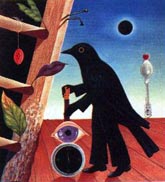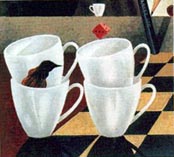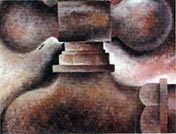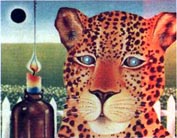STANLEY GREAVES OF GUYANA -
A CARIBBEAN MASTER
By Rupert Roopnarine - 'El Dorado' April 1995
It may be that no major Caribbean artist of our time has been more fecund and versatile than Stanley Greaves of Guyana who turned sixty last November and celebrated with a grand retrospective exhibition in Georgetown. On view was the full range of Greaves' art, from the figurative People of the Pavement series of the fifties and sixties, through the abstract Hearts and Diamonds explorations of the seventies and eighties to the enigmatic, veristic mini-paintings of the nineties.  When we take into account the enormously varied work in three dimensions, the wood carvings, multi-media constructs and ceramics, we cannot but be humbled in the presence of such a rare and uncompromising dedication to the creative life.
When we take into account the enormously varied work in three dimensions, the wood carvings, multi-media constructs and ceramics, we cannot but be humbled in the presence of such a rare and uncompromising dedication to the creative life.
Persons, both the knowing and the curious, who viewed his exhibition of mini-paintings (A Caribbean Metaphysic) held at the Queen's Park Gallery in Bridgetown, Barbados in October 1993, could be excused for coming away more perplexed than enlightened by the experience. Even the aficionados and art experts who have been paying attention to Greaves' output over the years would have had good reason to be taken aback by these meticulously drawn and painted little pictures, at once full of familiar things and excluding a deep and seemingly perverse strangeness.
Faced with over thirty paintings, each measuring 9" x 10", the first intriguing question that arises: why this size? Little paintings have some obvious advantages. They can be moved around easily, ideal carry-on size for the art-lover on the go. Ideal too for travelling exhibitions. One can imagine a small touring exhibition of these little paintings for schools and far flung communities, strangers to the art galleries of the capitals. These practical considerations, however, were the least of Greaves' concerns, if indeed, they occurred to him at all.
In the mini-painting, his interest in size is of a different order, more philosophical and aesthetic. Greaves calls them mini-paintings to distinguish them from the earliest miniatures that enjoyed a vogue in Europe from the 16th to the 18th century, portraits for the most part, which, painted on vellum and replete with arcane symbolism and allegory, proclaim their derivation from medieval manuscript illumination.
At times small enough to hold in the hand, the traditional miniature is simply a tiny painting, a miracle of reduction down to the minutest detail. Size as such is unproblematic. Smallness is all. Not so the mini-paintings, where the question of size, or more, of scale, becomes the actual point of departure for Greaves' newest investigations. "The format of the work is small", Greaves has written, "because it sets out to explore the view that ideas can determine the most efficient format or use of scale needed to give them full expression".
 The main technical exploration which Greaves embarked upon after beginning the series with The Birth Of Venus in 1989/90 centres around the relation between scale and theme. Searching through his notebooks for paintings which did not require a large format - it is his method of work - he selected all those which could be released in the (9" x 10" format he had settled on. He then discovered, as he worked, that some of the objects described in these paintings were painted at their natural size. Limes, nails, ants, needle and thread, pencils, buttons, an egg, a cherry - all could fit into the composition at their natural size.
The main technical exploration which Greaves embarked upon after beginning the series with The Birth Of Venus in 1989/90 centres around the relation between scale and theme. Searching through his notebooks for paintings which did not require a large format - it is his method of work - he selected all those which could be released in the (9" x 10" format he had settled on. He then discovered, as he worked, that some of the objects described in these paintings were painted at their natural size. Limes, nails, ants, needle and thread, pencils, buttons, an egg, a cherry - all could fit into the composition at their natural size.
"I noticed", he wrote in the Exhibition Catalogue, "that the use of objects more or less in their natural scale created a force that would have been destroyed if the scale was larger. A natural scale makes the paintings very accessible to the viewer. Moving away from natural scale creates a totally different feeling.  It is left to the artist to determine the specific effect desired". What the paintings show is that he used scale in a very deliberate and provocative manner, placing certain objects next to other objects that made them obviously out of scale. And it is precisely this out-of-scaleness that helps to create the atmosphere, the particular conditions, the emotion ("feeling") and the drama of the paintings. It is a strategic distortion of scale. This distortion is at times a compositional imperative. But size and scale are also traditional determinants of meaning, with things of importance painted big and things of less importance painted small. "My approach was to use two or three objects at natural scale and manipulate the scale of others according to the demands of my intuition and interpretation of the rules of pictorial composition".
It is left to the artist to determine the specific effect desired". What the paintings show is that he used scale in a very deliberate and provocative manner, placing certain objects next to other objects that made them obviously out of scale. And it is precisely this out-of-scaleness that helps to create the atmosphere, the particular conditions, the emotion ("feeling") and the drama of the paintings. It is a strategic distortion of scale. This distortion is at times a compositional imperative. But size and scale are also traditional determinants of meaning, with things of importance painted big and things of less importance painted small. "My approach was to use two or three objects at natural scale and manipulate the scale of others according to the demands of my intuition and interpretation of the rules of pictorial composition".
A working problem for Greaves: how to ensure that this flouting of the conventions of scale and proportion did not result in something ungainly, something awkward and askew. The board-walk of Guitar Bird, the checker-boards of Alison's Cups and Plantation Boots, He has sub-titled the Exhibition "a Caribbean Metaphysic". But do not expect to find here - or anywhere else in Greaves' work for that matter - any vulgarities of so-called Caribbean colour. On the contrary: a yearning after the close-harmonized, monochromatic palette achieved here in Tap No.2 and Alison's Cups No.3. Greaves is no colourist, in the sense that his fellow Guyanese Aubrey Williams or his close friend and colleague, Isaiah Boodhoo of Trinidad are colourists. Greaves has written of Williams, "expressions revealing the spiritual aspect of colour that stressed a contemplative approach to the act of painting". Distinguishing Boodhoo's "perceptual" approach from Williams, "internalized position", he sees them both as impassioned colourists, with Boodhoo working "to establish areas of textural colour reacting together with the degree of harmonic subtlety…………… directed to the investigation of the way in which nature reveals herself through colour". To say that he is no colourist is not to deny the long years of laboring in colour and testing its possibilities of revelation, as in the hearts and Diamond series of 1985, with its methodical explorations into the uses and functions of colour.
The paintings, Greaves has pointed out, "are composed of two categories of objects, those native to the region and those that are not, and refer to the somewhat gratutious nature of our existence". Caribbean then in the celebration of our birds and leaves and shrimps and ants.
Caribbean too in that they celebrate Greaves' childhood in working class Georgetown of the 30's and 40's. The Tap to recall the great municipal tank outside the St. George's Cathedral where little boys, among them the boy Greaves, went to buy the family's water from the Municipality at one penny a gallon during the dry season. The tap, centre of the social life of the yard, its heart and hub. The contents of a boy's pockets: a forbidden razor-blade in lieu of the forbidden penknife to work at his carving, buttons for trading, In the mini-paintings, Greaves reveals himself one of the Caribbean's most confident artists, a master of his media and an honest servant of the free imagination let loose on the ordinary things of our world. He is at once the most original and the most traditional of artists because he knows that all things have an origin and that it is from within tradition that we lay siege to tradition.
 the floor-boards of Red Eye, the checker-board roadway of Game Plan, with their Vermeer-like precision, all point to this Preoccupation. Take the house at the end of the Road-way in Game Plan
the floor-boards of Red Eye, the checker-board roadway of Game Plan, with their Vermeer-like precision, all point to this Preoccupation. Take the house at the end of the Road-way in Game Plan  Either the house is a miniature house covered by a natural sized leaf, or it is anatural sized house covered by a gigantic leaf. Or take the bird and fifth cup of Alison's Cups, which have a similar relationship. Or the boot and step of the sculptural Plantation Boots, the bird perched on the second black glass of
Either the house is a miniature house covered by a natural sized leaf, or it is anatural sized house covered by a gigantic leaf. Or take the bird and fifth cup of Alison's Cups, which have a similar relationship. Or the boot and step of the sculptural Plantation Boots, the bird perched on the second black glass of  Colour in the mini-paintings is entirely functional, used like other techniques to make the paintings clear. Except for Knot Nos. 1&2, Tap No2, Alison's Cup No.3, and Hooked Sandwich, limited palette and monochromatic paintings where paint is carefully worked and manipulated, colour is no more and no less a function of composition and meaning.
Colour in the mini-paintings is entirely functional, used like other techniques to make the paintings clear. Except for Knot Nos. 1&2, Tap No2, Alison's Cup No.3, and Hooked Sandwich, limited palette and monochromatic paintings where paint is carefully worked and manipulated, colour is no more and no less a function of composition and meaning. See them, minute survivors from forever, scouts perhaps for some great collective project, crawling over the surprisingly human face of Tap No.2, on the rim of the cup in Alison's Cups No.3 and on the burning fretwork in the foreground of Dalkeith Village, where mysterious fires burned down chattel-houses and where a blackbird, magically haloed, holds a lighted match in his beak. Caribbean especially in the abundance of the fruits of the region: the Barbadian cherry, the grapefruit, invented in Jamaica from the shaddock and other citrus brought to the West Indies by Captain Shaddock, green peppers, pigeon peas and the poised, elegant, feminine okra of the visitor, complete with her ruffle. Even a mild political satire of a great Caribbean Circumlocution Office where officials meet and meet and talk and talk and achieve nothing very much. Who of the Caribbean does
See them, minute survivors from forever, scouts perhaps for some great collective project, crawling over the surprisingly human face of Tap No.2, on the rim of the cup in Alison's Cups No.3 and on the burning fretwork in the foreground of Dalkeith Village, where mysterious fires burned down chattel-houses and where a blackbird, magically haloed, holds a lighted match in his beak. Caribbean especially in the abundance of the fruits of the region: the Barbadian cherry, the grapefruit, invented in Jamaica from the shaddock and other citrus brought to the West Indies by Captain Shaddock, green peppers, pigeon peas and the poised, elegant, feminine okra of the visitor, complete with her ruffle. Even a mild political satire of a great Caribbean Circumlocution Office where officials meet and meet and talk and talk and achieve nothing very much. Who of the Caribbean does  not know that rooster set to crow into the microphone? The nut with no bolt? And the paper clip, essential tool of the paper trade, fore-shortened to draw you into thc space of the painting (The spoon of Bird Bread, the knife come to visit in The Visitor, the nail of Plantation Boots, the scissors of the The doll, and the umbrella of Red Eye, all have the same function).Utterly Caribbean in the two "obeah" paintings: The Doll and Jaguar Table, where buttons have turned into celestial objects caught in the eyes of the Doll and the well dressed macaw.
not know that rooster set to crow into the microphone? The nut with no bolt? And the paper clip, essential tool of the paper trade, fore-shortened to draw you into thc space of the painting (The spoon of Bird Bread, the knife come to visit in The Visitor, the nail of Plantation Boots, the scissors of the The doll, and the umbrella of Red Eye, all have the same function).Utterly Caribbean in the two "obeah" paintings: The Doll and Jaguar Table, where buttons have turned into celestial objects caught in the eyes of the Doll and the well dressed macaw.  And a jaguar, exactly spotted, stares out of eyes an arctic blue, cold European eyes in the head of a tropical beast. In these two paintings, objects take on a votive aspect, combining to achieve an effect of eeriness.
And a jaguar, exactly spotted, stares out of eyes an arctic blue, cold European eyes in the head of a tropical beast. In these two paintings, objects take on a votive aspect, combining to achieve an effect of eeriness. bent nails left over from the last rainy day when the boy Greaves had to get his hammer and straighten bent nails for his father, a rainy day chore in the work-shop, a place of magic and surprizing transformations.Indeed allusions abound to Sweetie Greaves and his myriad manual professions: rope-mender and master of splicing and knots, dice maintenance specialist who would receive dice which had become unreliable to the gambling men from the race-course and sand and balance them until they were true. And the tastes of childhood: Weiting and Richter's Edge-a-Boy biscuits, the point of departure for the finest of the pieces, Biscuit Story No.1.
bent nails left over from the last rainy day when the boy Greaves had to get his hammer and straighten bent nails for his father, a rainy day chore in the work-shop, a place of magic and surprizing transformations.Indeed allusions abound to Sweetie Greaves and his myriad manual professions: rope-mender and master of splicing and knots, dice maintenance specialist who would receive dice which had become unreliable to the gambling men from the race-course and sand and balance them until they were true. And the tastes of childhood: Weiting and Richter's Edge-a-Boy biscuits, the point of departure for the finest of the pieces, Biscuit Story No.1.